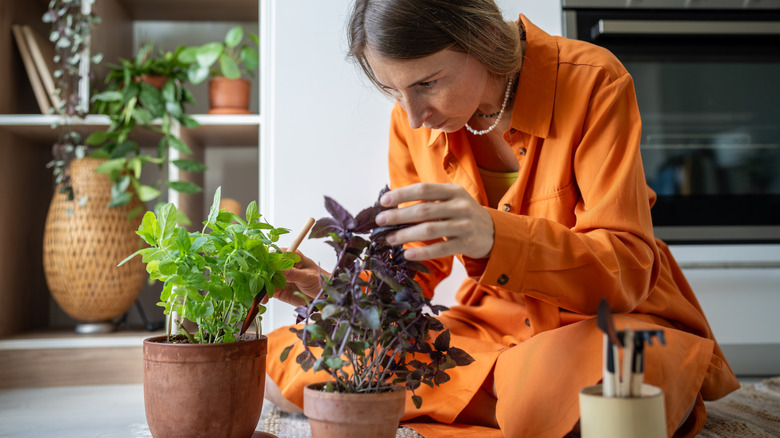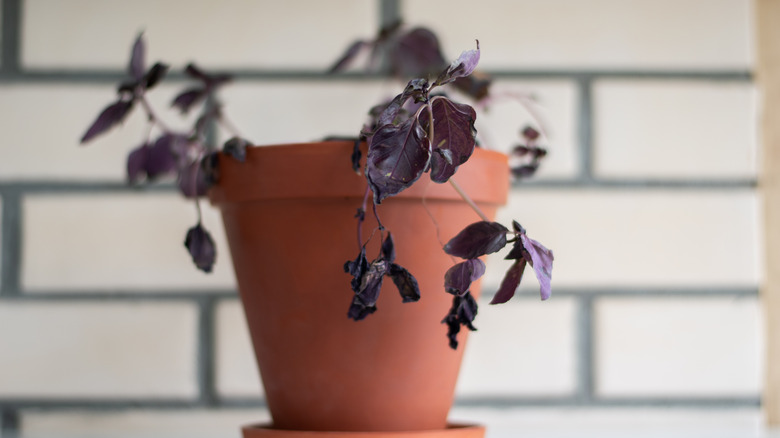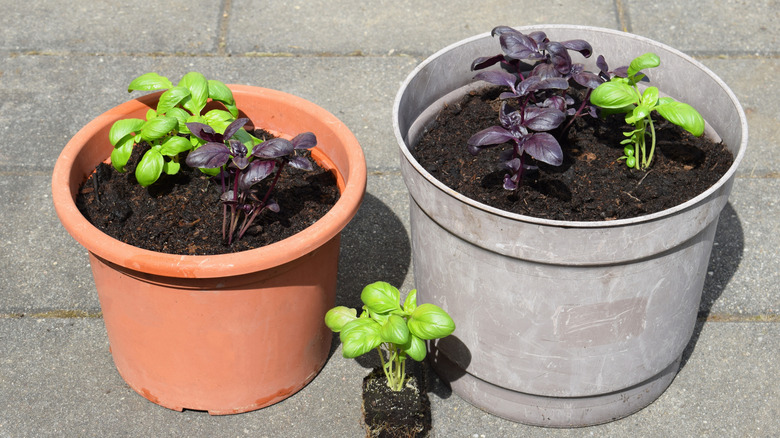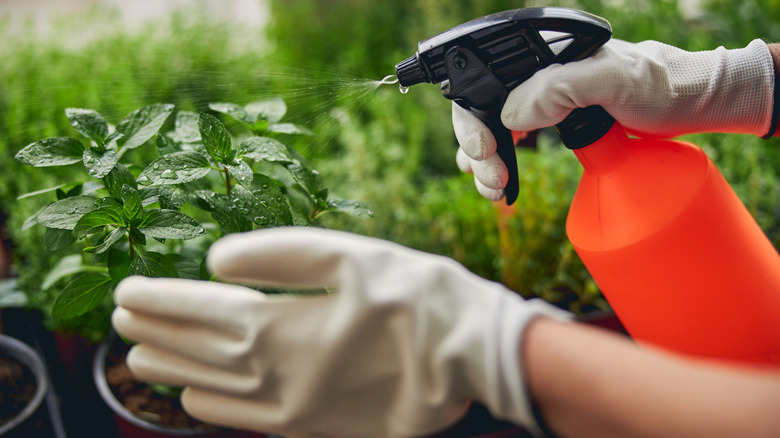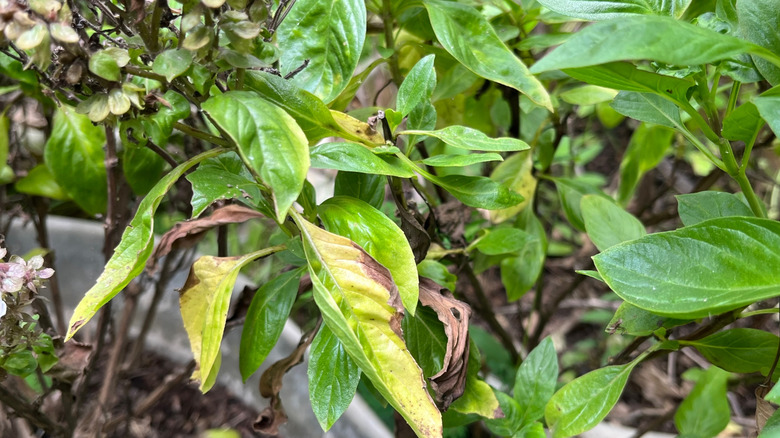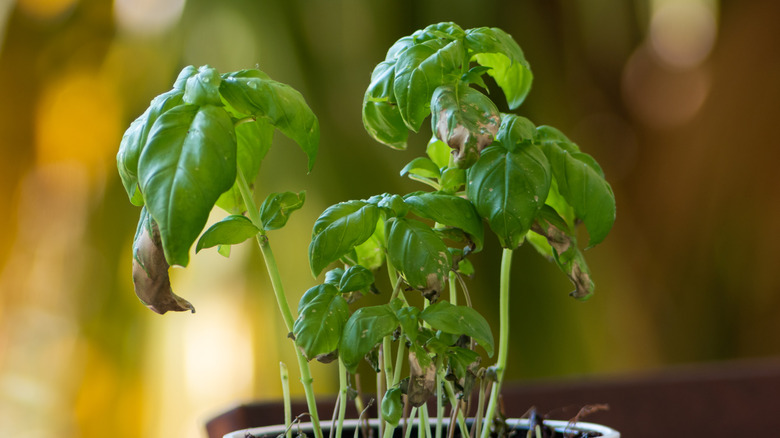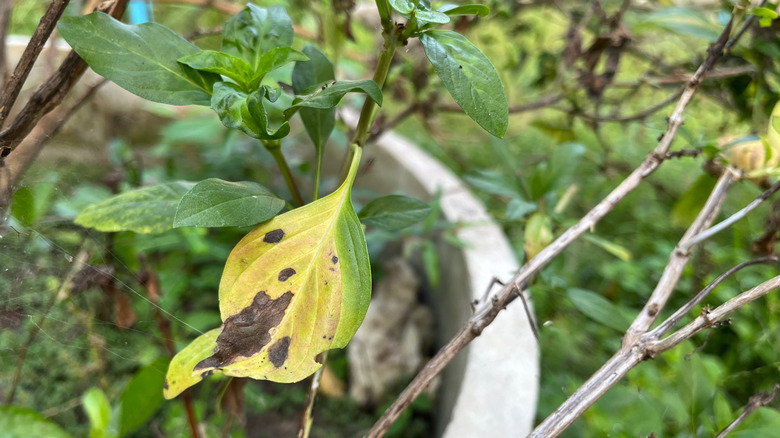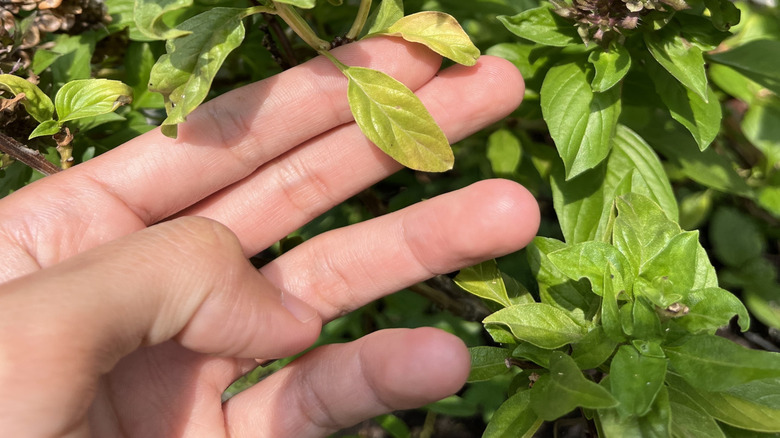10 Common Issues You Should Know About Before Growing Basil
We may receive a commission on purchases made from links.
To many, basil (Ocimum basilicum) seems like a breeze of an herb to grow. But don't let its popularity fool you; not all basil is created equal, so successfully growing basil to ensure a bountiful harvest comes with a few quirks you'll want to know about before picking up that seed packet. Turns out, basil can be a bit picky about things you might not expect, and it's got a few hidden weaknesses too — from its dislike of cold snaps to its susceptibility to a whole host of pests and diseases that can quickly decimate your crop. Even seemingly minor factors, like the type of pot you use or the salt content of your water, can significantly impact growth, leading to stunted plants or even complete failure.
So, before you send another potted plant to the compost heap, let's explore the common issues that beginners often run into when growing basil, which range from basic environmental needs to more complex pest and disease management. We'll also go over ways to ensure your herb garden stays happy and healthy year-round, producing a bounty of fragrant leaves.
Basil isn't cold hardy
Basil is notoriously sensitive to cold, and even a light frost can cause significant damage, including wilting or death. It's not just freezing temperatures; even a drop to around 50 degrees Fahrenheit can lead to stunted growth and unhappy plants. Don't be fooled by a few warm days, either; a sudden temporary dip in temperature can spell disaster for your basil plants if you're not prepared.
To keep your basil thriving when the weather's not cooperating, you'll need to prioritize maintaining a consistently warm environment for your plant or seedling. If you're planning to grow it outdoors, start by avoiding the temptation to plant it too early and wait until both the air and soil are consistently above 50 degrees Fahrenheit. Keep an eye on your weather forecast, and if a cold snap is on the horizon, provide protection from freezing temperatures by covering outdoor plants with frost cloths or bringing your potted basil indoors. While you can use old sheets, blankets, or towels to cover your basil plants, frost clothes are more effective at trapping warmth and let light through, which allows you to keep them on during the day. They're also relatively affordable; for instance, this 10-foot by 30-foot Homoda Plant Cover costs less than $20 on Amazon.
If you're starting your basil indoors, ensure they have a warm, sunny location, or use grow lights to mimic ideal growing conditions. Some gardeners will opt for using a greenhouse or terrarium to maintain proper temperatures for their basil. If you decide to go that route, just ensure that there is adequate ventilation, so that the basil plants do not overheat. Heat mats are also a great way to warm up the soil and are pretty affordable — you can pick up a two-pack of the Vivosun Waterproof Seedling Heat Mats for around $20.
Basil will act like a drama queen if it doesn't get enough water
Basil can be a real drama queen when it's thirsty. If it's not getting enough water, it'll throw a full-on leafy tantrum, drooping like it's given up on life. It's easy to mistake this dramatic droop for a plant that's kicking the bucket, but often, it's just a cry for a good, long drink. Potted basil is particularly dramatic about this as the soil tends to dry out faster than around in-ground plants.
To avoid these dramatic displays and stop your basil leaves from wilting, keep a close eye on the soil's moisture. Before watering, stick your finger a little way into the soil; if it feels dry, it's time to water. If you don't trust your judgment, try using a tool like the Hathdia Moisture Meter.
Give it a thorough soaking, allowing the water to drain completely. Consistent watering is key, especially during hot, dry spells. If you notice your basil starting to droop, don't panic. Give it a generous watering, and you'll likely see it perk up within a few hours, rising from its leafy death-like state like a botanical Lazarus. Remember, basil appreciates consistent moisture, but avoid overwatering, as this can lead to root rot.
Different species of basil have different lighting needs
Here's a little secret about basil: Not all varieties are created equal, especially when it comes to their love of light. You can't just plop any basil plant in any sunny spot and expect it to thrive. Different species have different lighting needs, and ignoring this can lead to leggy, weak plants instead of the lush, bushy basil you're dreaming of. Some basil varieties are perfectly happy with a good dose of bright, indirect sunlight, while others crave the full, blazing sun to really flourish.
To keep your basil happy, you'll want to do a little research on the specific variety you're growing. While many common basils thrive under standard grow lights or in sunny windowsills, purple basils, like 'Dark Opal,' can handle much more intense light and may even produce higher yields under brighter conditions. On the flip side, some varieties, like 'Anise', 'Cinnamon', or 'Thai Magic', might get stressed out if given too much light. Also, if you're planning to use an LED light, make sure it's full-spectrum. A 2022 study in Frontiers in Plant Science found that different cultivars of basil had their own unique photoreceptors, meaning some needed more red light while others reacted better to higher levels of blue light. A full-spectrum grow light, like the 5000K White Full Spectrum Plant Growing Lamps by Barrina, tackles this easily and saves you the effort of needing to tweak your lighting just so for each plant.
Growing basil in biodegradable starter pots could result in lower growth
Wondering whether you should switch to those eco-friendly, biodegradable pots to start your basil seeds? It sounds like a good idea; after all, biodegradable pots help reduce transplant shock. Unfortunately, your basil might not be as thrilled as you'd expect. Turns out, certain biodegradable materials, like corn starch-based bioplastics and starch-based polymers, can actually hinder root and shoot growth in basil. So, while you're trying to do right by the planet, you might be accidentally stunting your basil plants.
This doesn't mean you have to ditch the idea of sustainable seed starting altogether — just be mindful of the materials you choose. Plantable containers made from coconut coir, paper, rice hulls, straw, or wood fibers are generally considered safe and effective. Some examples include the Deepthi Coco Coir Nursery Pots and Back to the Roots Wood Fiber Seed Starting Pots. If you're using homemade or commercially available biodegradable pots, it's worth doing a little research to see if they've been linked to growth issues. You might find that your basil thrives in some types of biodegradable pots, but struggles in others. The key is to be aware of the potential impact and choose your materials wisely, so that you strike the right balance between eco-consciousness and happy basil plants.
Salinity will severely affect basil's nutrient uptake
You might not think about it much, but the salt content in your water can seriously mess with basil's growth. Turns out, basil is pretty sensitive to salinity, and even slightly salty water can throw its whole nutrient uptake system out of whack. Studies have shown that increased salinity leads to reduced biomass production, lower chlorophyll levels, and a decrease in the plant's ability to absorb essential nutrients. Unfortunately, salt in water is more common than you might think. Tap water and well water can contain surprisingly high levels of sodium and chloride, especially if you're dealing with road salt runoff, water softeners, natural salt deposits, or even certain fertilizers. This means that your seemingly innocent watering routine could be slowly sabotaging your basil's growth.
To avoid a salt-induced basil meltdown, you'll need to be a bit more discerning about your watering habits. Consider using filtered water or rainwater for your basil, as these options are typically low in salinity. If you're relying on tap water, let it sit out for a day or two to allow some of the chlorine to dissipate, which can also contribute to salt buildup. If you're using well water, it might be worth getting it tested for salinity levels before buying your basil plants or seeds. You can also use something like this Abnaok Salinity Tester to check your water. Testing is especially important if you live in an area prone to road salt runoff or where natural salt deposits are common.
Basil is very susceptible to downy mildew
If there's one thing that can really take down a basil plant, it's downy mildew. This isn't a basil-specific disease, but basil is susceptible to it from the moment it sprouts. The telltale signs include yellowing leaves with a grayish-purple fuzz on the underside, and once it takes hold, it can spread rapidly. This disease thrives in damp conditions, making overhead watering and poor air circulation prime culprits. If left unchecked, downy mildew can lead to significant losses, both for home gardeners and commercial growers alike, making it a serious concern for anyone growing basil.
Downy mildew's been a real headache lately in U.S. gardens, having first shown up on basil plants in the country in 2007. In the following years, it became such an issue that it even led to significant economic loss on the East Coast. Prevention is key with downy mildew, so opt for downy mildew-resistant varieties such as 'Obsession,' 'Devotion,' 'Passion,' or 'Amazel' right from the start.
If you notice signs of downy mildew, you'll need to act fast, because this disease can spread like wildfire, quickly decimating your basil plants. Immediately remove any affected leaves or stems to prevent further contamination. If the infection is widespread, consider using a fungicide. Trials have shown that phosphorous acid and Cyazofamid can provide a level of control over the parasite that causes downy mildew on basil. Amazon stocks the Segway O Greenhouse and Nursery Fungicide, which is now labeled for use on herbs, particularly for downy mildew on basil. If you'd prefer to try a more natural approach, you can also a product like GrowSafe's Bio-Pesticide which is labelled for use on downy mildews and only contains corn and soya bean oil as its active ingredients.
Basil is vulnerable to Fusarium wilt
If you notice a young basil plant sporting a brown stem, that's a serious red flag and could be a sign of Fusarium wilt, a fungal disease that can quickly spell doom for your basil. This nasty fungus sneaks into the plant through its roots and messes with its water transport system, which is like cutting off its lifeline. You'll start to see slow growth, yellowing leaves, and generally unhappy-looking foliage. And then, the stem turns brown at the base, signaling that the plant is on its way out.
Unfortunately, once Fusarium wilt takes hold, there's not much you can do. The infected plant will eventually wilt, drop its leaves, and die, so prevention is key here. Make sure you're planting your basil in well-draining soil, as this fungus thrives in damp conditions. Avoid overwatering, and if you're growing in containers, ensure they have adequate drainage holes. Also, practice good garden hygiene by removing any infected plants immediately and discarding the soil to prevent the spread of the disease. Choosing disease-free seedlings or seeds from reputable sellers can also reduce your risk, as can rotating your basil plants to new locations each year.
Pseudomonas leaf spot is a common problem
Another nasty surprise basil can throw your way is pseudomonas leaf spot. This bacterial disease is a real pain, showing up as dark, water-soaked spots on the leaves. These spots can be angular, following the leaf's small veins, or they can be irregular, making them tricky to spot at first. And if that's not bad enough, it can also lead to a wet stem rot, which can quickly take down your plant.
Like many plant diseases, pseudomonas leaf spot thrives in wet, humid conditions, so avoid overhead watering, ensure good air circulation, and promptly remove infected leaves. Also, don't forget to properly sanitize your tools before and after use to prevent the infection from spreading. The bad news is this bacterium can be seed-borne, so even new plants might be infected. Pseudomonas leaf spot is too small to spot on seeds with the naked eye, so choosing seeds from reputable suppliers who certify disease-free stock is your best defense.
Not all varieties of basil are disease-resistant
While there are basil types that show some natural disease resistance, not every cultivar or variety is as tough, and picking the wrong type can give you more of a headache than you probably planned for. This is a crucial point to remember, as some varieties are significantly more vulnerable to diseases than others. Unfortunately, just grabbing any basil plant off the shelf at your local big box store and expecting it to thrive is a risky move that can cost you time, money, and — let's be honest — a little bit of sanity.
The best way to ensure you've got a hardy cultivar is by doing some research before heading out to buy your basil. In addition to the aforementioned downy-resistant types, 'Red leaf,' Newton, and the Thai varieties 'Lemon' and 'Lime' are good choices. Thai (Ocimum tenuiflorum) basils in general also show a level of hardiness against fungal diseases. Rutgers University has also created non-GMO varieties that show excellent fungal resistance, including Rutgers 'Thunderstruck DMR.' However, remember that "disease-resistant" doesn't mean "disease-proof." New pathogen races can emerge, overcoming even the best defenses. So, while these varieties give you a head start, you'll still need good garden hygiene, proper air circulation, and to continually monitor your plants for symptoms. Think of using these types in your garden as an added layer of protection, but not a guarantee, in your ongoing battle against basil diseases.
Japanese beetles love to feast on basil
If you've ever seen your basil leaves looking like they've gone through a shredder, chances are Japanese beetles (Popillia japonica) are the culprits. These little pests are daytime diners, and basil is one of their favorite buffets. They'll chow down on the leaves, leaving behind just the veins, which is a pretty clear sign of their handiwork.
To combat these pests, you have a few options. One effective, albeit hands-on, DIY approach for getting rid of Japanese beetles is to knock them into a tub of soapy water – the soap will break the water's surface tension, ensuring the beetles drown. For larger infestations, or if you prefer a less hands-on method, consider using an organic insecticide specifically labeled for use on herbs, such as the Bonide Captain Jack's Neem Oil, which many buyers report solved their Japanese beetle problem. Just be sure to read and follow the label instructions carefully to ensure both your safety and the effectiveness of the treatment. And, as with most things pest- or disease-related in the garden, a watchful eye and early intervention are your best defenses against these leaf-munching menaces.
Basil needs specific nutrient requirements when growing in hydroponics
Basil is one of the top plants you can grow in an indoor hydroponic garden. But, if you're thinking about growing basil hydroponically, you'll quickly learn that it's not just about water and light. Unlike basil grown in soil, where nutrients are readily available, hydroponic basil is totally dependent on what's in its water and requires a more precise balance than you might expect. Without enough nitrogen, phosphorus, potassium, or magnesium, mature leaves will be affected. Meanwhile, a lack of calcium, iron, and boron affects new growth and may keep your plant's harvest smaller than you hope for. Finally, if your basil's water supply is deficient in sulfur, both new and mature leaves will begin to yellow.
But don't give up just yet — there's a reason it's such a popular plant for this method, and all it requires is ensuring you've got the right nutrient solution. First, make sure your water's pH level is just right — basil needs between 5.8 and 6.2. Also, keep in mind the source of your water so that its salinity levels aren't too high. In terms of nutrients, the simple version is that your basil plant isn't particularly picky, but does prefer fertilizers that are slightly higher than normal in magnesium. If you've already bought your nutes and are worried that the baby basil plants will need a magnesium boost, you could try rounding things out with something like Bloom City's Cal-Mag Growing Fertilizer or some Epsom salts at a ratio of roughly 2 pounds for every hundred gallons of. Whichever additive you choose, begin adding it sparingly, then monitor the results. If your basil shows signs of under-fertilization, like low growth or chlorosis — yellow or pale green leaves— then add more.
The more technical answer for those who love to get science-y with their gardening is that you should add a fertilizer that gives your water the right level of electrical conductivity (EC). EC is measured as millisiemens per centimeter (mS/cm) and is extremely important with hydroponics, as too high a level means there's a higher salt concentration, which, as we've discussed, is a big deal for basil. Meanwhile, too low an EC level will result in nutrient deficiencies and lower growth. Basil does best with nutrient solutions that keep the EC level between 0.5 to 1.5 mS/cm. Remember to routinely check nutrient and pH levels, particularly as you add more water to the reservoir.
